Iridium’s GO! satellite WiFi and Globalstar’s mysterious SatFi
Wow! With a bounty of significant cruising electronics news on my desk, the new Iridium GO! may rank #1. Think of it as the Iridium Extreme — arguably the most versatile, rugged, and expensive sat phone available — with the phone interface replaced by a WiFi radio able to handle five smartphones or tablets. The GO can install semi-permanently with an external antenna, or sit on deck while you make a quiet call below, or go in your pack when you hike in Tierra del Fuego. You’ll still be able to make and take phone calls anywhere, but they will be easier, less expensive, and purportedly better sounding. Plus there’s global email, tracking, and so much more…
My review of the Extreme and its AxcessPoint WiFi accessory in 2012 was somewhat lukewarm. It wasn’t the service so much as the complicated jumble of components, cables, and chargers involved, plus a phone interface that seemed clunky in this iPhone/Android age. But I wasn’t smart enough to visualize how it could all be simplified into the 4.5 by 3.25 inch GO with benefits added (and I doubt that Iridium’s competition was either, as explained below).
The key to GO is that you use your own phone or tablet (or PC eventually) to access the full speed Iridium 9523 modem that’s normally in their sat phone. It’s “like having your own global cell tower” Iridium likes to say. It’s also something like Google Voice which let’s me make voice calls and texts whlle roaming foreign cell lands just by finding a WiFi Internet connection and tapping a setting on my Android phone.
But that analogy is only half true because even a dicey WiFi hotspot has a lot more bandwidth than a full speed Iridium circuit switching modem. So GO users can not just use their phone’s normal software for email, calls, or anything else. Special apps must be developed to bridge cell/wifi broadband expectations with Iridium narrow-band realities…
But before discussing all the app possibilities, known and unknown, note the water-protected ports on the GO. The ubiquitous mini USB is used to charge the device’s Lithium battery — a nice change from prior Iridium charge systems — and possibly for firmware updates. The red button, also protected from accidental finger pushes, is of course a quick way to send a distress alert. Since GO has internal GPS it can be left on to provide tracking, be ready for an emergency, and/or keep an ear out for incoming messages.
If all that sounds like a DeLorme inReach, well, it is, except that the inReach’s SBD (short burst data) modem can’t also handle calls, slim email, weather files and even limited Web browsing. In fact DeLorme is listed as one of partners developing apps and extra services for the GO in Iridium’s press release and I hope to wheetle some detail out of them here in Miami. OCENS weather too.
So no surprise that the Iridium GO app that will be available when the device ships in a few months looks similar to the Earhmate apps for the inReach (except without all the mapping DeLorme throws in). Settings, tracking, messaging, and a second way to call for distress (with two-way texting) are all there. This app is also where you make satellite phone calls, apparently with access to your regular contact list. Tim Johnson, Iridium’s Director of Mobile Business, told me that attendees at last week’s Partner’s Conference were smiling about how their smartphone audio technology improved the quality of calls over the Iridium network.
There will also be an Iridium Mail & Web app that works with the GO, and I was glad to learn that it is a version of the software that Luis Soltero of Global Marine Networks developed for the Iridium AccessPoint. That means offline email editing, batch transmissions with compression, filtering of large attachments and many other nuances that are critical to narrowband communictions. Soltero has been testing a GO and terms it “all in all a sexy product priced very reasonably with a growing community of mobile apps.”
So what about the costs? Iridium won’t put hard numbers on anything because they don’t sell direct, but Tim Johnson expects the GO hardware to retail at $800 to $900 and he confirmed Soltero’s news that GO will get special low-priced service plans, like “$130 to $150” per month for unlimited data. I asked Johnson to repeat that, as it sounds ideal for certain cruising situations, especially if available in “seasonal” increments. DeLorme’s new “Freedom Plan” makes me hopeful, but we’ll have to wait.
Iridium is marketing GO as an improvement on the Thuraya SatSleeve design and even created a Go! to SatSleeve comparison PDF. There’s not much comparison, in my view, except maybe that the SatSleeve is slightly more portable. What seems odd, though, is that Iridium left out the new Globalstar SatFi. But maybe not so odd as it seems quite possible — no photos, no specs, no rumors — that Globalstar heard about GO and just pulled SatFi out of a hat, or somewhere. Heck, I’ve even seen email showing that people working at Globalstar didn’t know about SatFi before its late January announcement. And if it is vaporware, it worked at least a bit as when Engadget’s GO coverage begins with “Globalstar’s Sat-Fi won’t be the only game in town for satellite hotspots.”
I think that Globalstar did a great thing for boaters with their SPOT tracker messengers, and I hear that the phone/data service is getting better. I also think that it would be great to have competition over this new satellite WiFi hotspot platform. But a vauge just-started product that may not be real until November (according to a knowledgable sounding investor) seems like poor sportsmanship and possibly confusing to consumers.
I can close with something much more positive. I’d hoped that a company like Raymarine might use the Bluetooth in their MFDs to integrate with the DeLorme inReach. Wouldn’t it be neat to get important message notifications on your bright, waterproof nav screen and be able to type a reply? Not to mention distress communications, weather alerts, etc. But actually the new Iridium GO with its greater data capacity and more common WiFi interface makes more sense. For instance, how hard would it be for Furuno to make the NavNet TZT weather via WiFi feature to work directly through GO if Iridium cooperates? Tim Johnson’s answer to my query about such possibilities was “absolutely yes!”


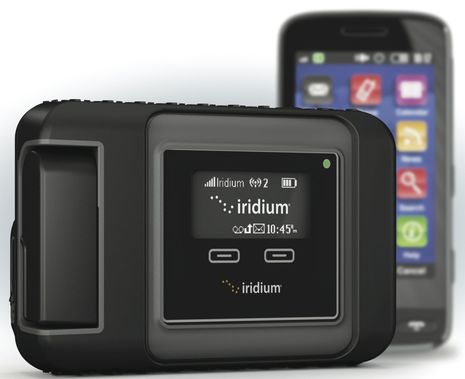
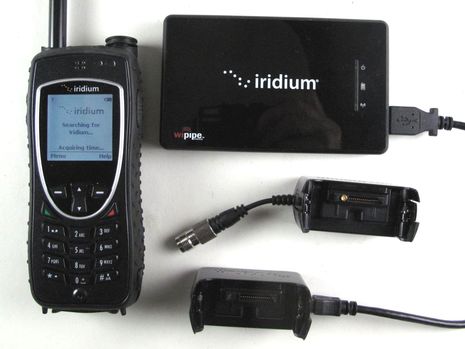
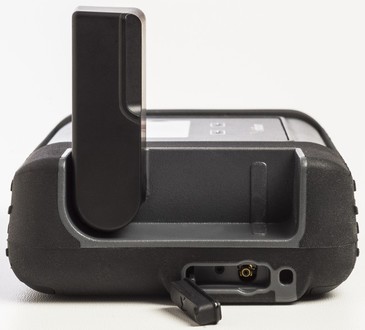
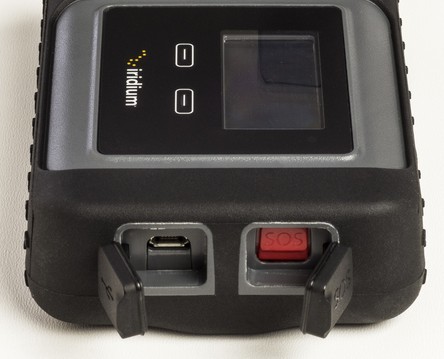
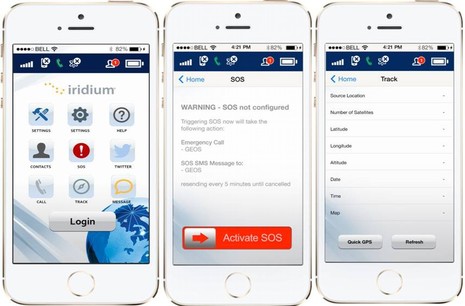
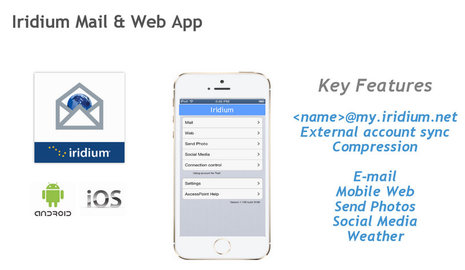
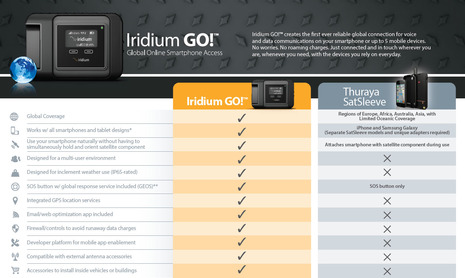
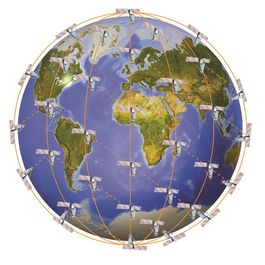
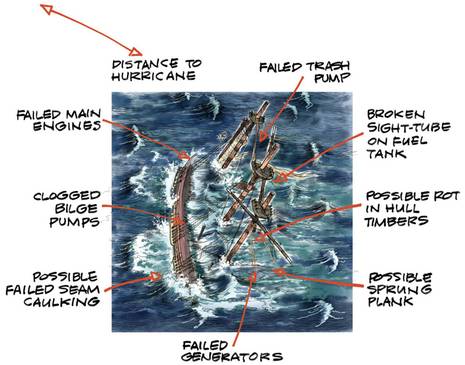










Just what I was waiting for in Satellite Comms… Easy to install, easy to use, hopefully combined with a reasonable data plan… on top of Iridium’s super benefit of reliability and 90N to 90S global coverage.
If they get the plans right this will blow all existing solutions away. Dedicated satellite phones with their 1990s style interface all seem very old fashioned suddenly.
Sat-Fi, trademarked 2 years ago by Globalstar.
Sat-Fi, trademarked two weeks ago by Globalstar:
http://tess2.uspto.gov/bin/showfield?f=doc&state=4809:p1pe4t.2.1
GMN/RedPort Global here, with a few comments.
For land-based users and weekend boaters, the Go! is undoubtedly a great product, and we’re thrilled to see the industry embrace the concept we introduced with the RedPort Optimizer Wi-Fi router in 2011. For those not familiar, the Optimizer connects to any satellite phone or terminal to create Wi-Fi hotspot that works with your smartphone, tablet or computer. http://www.globalmarinenet.com/satellite-phone-data-optimizer.php
While we love the Go! for casual usage on a boat, we believe that for fixed maritime and in-building installations the RedPort Aurora is a better product.
Why? Like the Go!, the Aurora is an Iridium-based terminal that uses apps for voice and data connectivity. However, to permanently install the Go! on a boat, you need to use an external antenna and LMR antenna cable, an connect a power source to it (or charge the battery frequently), which makes for a trickier installation, and adds cost to the Go!. Plus, the Go! does not have an Ethernet connection to create a local network if you’d like to use that instead of the Wi-Fi.
The Aurora is a single dome designed for fixed installation with a standard maritime mount. There are no below-deck units to install, just a single Ethernet cable that can be used used for power, or to connect to an existing vessel network. The Ethernet cable is vastly easier to run than LMR cable.
Additionally, both the Go! and the Aurora work with both XGate satellite email software and Iridum Mail & Web, giving customers options for their email/web/weather/social media service. Both are excellent products.
For more details, see: http://www.redportglobal.com/marine-satellite-internet-firewall-routers/aurora-iridium-marine-terminal/
The Aurora is available for sale today: http://www.globalmarinenet.com/catalog/aurora-iridium-wifi-terminal-p-2865.html
John, any idea what the Aurora draws at 12V? I like the approach, and the features look very nice – how much power does it need?
Hartley, the Aurora draws 1.5 amps when transmitting less than .5 when idle. Because it uses PoE (Power over Ethernet) it can be used with either an Ethernet injector or plugged into a router with a powered Ethernet port.
OK – so 18 watts in TX and 6 watts in receive. Is the PoE injector that’s included a 12V device?
The reason I ask is that I see PoE is a 37-50 volt service, not 12V, so the injector must be some sort of converter/power supply.
Thanks!
Aurora is priced at $1999 and requires one of the current Iridium service plans.
The Go! will be $800-900 and have unlimited plans around $130-150.
Will likely take out my old Iridium and upgrade to the Go! and utilize existing cable run/antenna.
As a bonus we get all the great GMN software for free when using Go. Kinda cannibalizes the GMN proposition.
Hi Cire,
As mentioned, we also think the Go! is right for a lot of people. A couple of comments regarding your post:
Initial indications from actual Iridium providers indicate that the actual SRP will be $895. For someone who doesn’t mind putting the Go! on deck and recharging the battery as needed, it’s a great product at a great price. Another alternative is to purchase a remotable antenna, LMR cable and mounting it. In this configuration, the only thing missing in the Go! compared to the Aurora is the GPS NMEA repeating.
Iridium has not yet indicated whether they will expand their service pricing to other hardware devices yet.
Both RedPort Aurora and Iridium Go! work with both Iridium Mail & Web and with RedPort XGate (and its variants).
The key difference is that Iridium Mail & Web works only over Iridium airtime, but has no monthly fee for service. XGate works over any network connection (for example, over Marina Wi-Fi or your home network) but generally requires a monthly service fee.
They are different products for different customers, and we’re happy for the success of both.
The GO! is an inspired solution. Rate plans will be the pivot if it is to become a killer app. For our use, the GO! is a safer install solution than Aurora; smart antennas have the liability that if it gets knocked off the boat, you loose the entire transmitter. Lack of a rj45 on the GO! is an oversight but not a deal killer. PoE would be nice too.
Not to detract from the hard work leading to their products, the advert for redport and GMN seems a little over the top for this forum?
I can’t wait for this!! I hope it ships with a reasonable rate plan b4 my offshore trip north in May.
I hate running blind on weather. Sandy almost snagged me because i was offshore and blind when it formed. Not great seamanship (not arguing that) but the current options just suck. This looks like it might be really good for saildocs grib files (grib via email for free).
Any word on a shipping date? I need to put together an Iridium package for an offshore race in June. This looks perfect for my needs, but it makes me uncomfortable cutting things so close.
The SatPhoneStore is taking Iridium GO pre-orders:
http://www.satphonestore.com/iridium-go-global-online-smartphone-access1.html
And I also queried Iridium about the ship date this morning.
Iridium reply about GO delivery date: “The expected launch date is still ‘Q2’ which is best interpreted as late May, early June.”
With an SSB you don’t have to run blind — and no plan required
Satphonestore shows the GO “in stock”, and priced at $875, though they list shipping as June. Plans start at $49.95 (for a very limited usage).
I am anxious to hear some user reports before taking the leap.
I notice that no one has indicated transmission speed. Thought I read that it’s 2.4kps. BTW, SatFi was announced two weeks prior to Iridium, not the other way around. I’m holding off to see what Globalstar brings to the party, certainly lower entry point (around $300 was mentioned) and faster speed because their satellites are brand new. No thanks, I’ll wait.
You might want to reread the entry, Jim; I correctly reported that Globalstar announced SatFi in late January, which was before Iridium announced GO in early Febuary (but when many people like me had already heard about GO on an embargoed basis). What struck me as odd was that Globalstar did not include a photograph or hardly any other detail of SatFi.
Guess what? It’s more than three months later and I still don’t see photographs, pricing, or specifications for SatFi. Please correct me if I’m wrong. I think it will be great if there’s a cheaper, faster alternative to GO, but right now I’m in “I’ll believe when I see it” mode with Globalstar.
John with Global Marine Networks / RedPort Global here. Ben, In response to your post of May 26, the Globalstar Sat-Fi is now available for sale online. http://www.globalmarinenet.com/globalstar-sat-fi.php
Pre-orders of the Iridium GO! are of course also available: http://www.globalmarinenet.com/iridium_go.php
Thanks, John! Great to see that Globalstar Sat-Fi is for real, and I guess my skepticism was unwarranted. Jim (commenter above) may be disappointed with the $999 price, but the specs look promising. I also see that the data and voice apps are available at GooglePlay and iTunes:
https://play.google.com/store/apps/developer?id=Globalstar+Inc
https://itunes.apple.com/us/app/sat-fi/id881495410?mt=8
And that Globalstar itself has posted lots of info:
http://www.globalstar.com/sat-fi/lander.php?pk_campaign=satfi_lander
John, are you seeing good data rates in your testing?
PS: John, I checked out the Sat-Fi service contracts at GMN and see that users have to agree to a line that reads: “I understand that there are some temporary limitations to the Two Way Voice and Data Services on the Globalstar Satellite Constellation.” That line links to a Globalstar Constellation Update — http://www.globalstar.com/en/index.php?cid=107 — which is more than a year old and which suggests that only two of the new satellites is fully functional. Hopefully just a web publishing oversight?
Ben,
Globalstar data rates are 9.6 Kbps. While all providers speeds vary slightly from published rates (both up and down) we find that for virtually all purposes, the published rates are good benchmarks.
Regarding the service contracts on the globalmarinenet, yes, they just haven’t been updated. Globalstar’s official network statement is here: http://www.globalstar.com/en/index.php?cid=7010&pressId=792
This is a good time to be a satellite data user. There are new products that support mobile devices from all of the carriers , each with its own advantages, and at generally lower prices than any comparable equipment cost just a short while ago.
Thanks again, John, but I still feel the need to play the curmudgeon. The “official network statement” you linked to is general marketing with no specifics about the new satellites actually being in service. People buying the hardware and service plans still must agree that they understand about “temporary limitations” to voice and data with a link to a constellation update saying that most of the new satellites were expected to be put in service a year ago. That seems strange. If they are in service — and I hope they are, 9.6 Kbps is sweet compared to Iridium’s 2.4 and the Inmarsat phone’s less-than-2.4 — why doesn’t Globalstar say so?
Ben,
The limitations notice was our error – our web team just didn’t delete it when we should have, but it’s now gone. Iridium and Globalstar products and services each have their own advantages. I’d encourage you to look at the whole new BYOD landscape once with all the products coming to the market over the next few months.
Excellent news, John. So I guess the new GlobalStar sats are all operational and there’s no need for “limitations” disclosure. Cool.
I realize that Globalstar has much better data speeds (like 4x) than Iridium while Iridium has much better coverage of deep sea and high latitude areas. And I too am excited about the BYOD concept, though I had to use Google to find out that means “bring your own device” as in the GO and Sat-Fi WiFi boxes are like sat phones except that you use your own smartphone (or tablet) for voice calls, device management, data downloads, etc.
Not that voice part is so important anymore. I think it’s telling that when Jeff Bezos introduced the new Amazon Fire phone last week, he admitted that he hadn’t actually tried to make a call on it. At any rate, I hope that GMN will put up some reviews of the new sat WiFi devices, as you have in the past, and I also hope to try them myself.
http://nymag.com/daily/intelligencer/2014/06/why-are-we-still-calling-them-cell-phones.html?mid=google
I am still finding this technology ‘leap’ intensely frustrating.
The GO has a couple of serious limitations:
a) describing it as a wireless hotspot is intensely misleading as that implies an open access to the Internet, when, in reality, you can only connect (at this time) through Iridium supplied apps so no Pocket Grib etc.
b) the real killer, you can only use the iridium supplied email address and this address can ONLY be accessed through the GO. No collecting you attachments when on wifi, no checking the mail when you get home (unless you are happy paying for satellite time while connected to a broadband network. Not me. You MIGHT be able to use a web-based mail like Gmail but you would give up any bandwidth management tools. This issue alone puts the GO in the ‘toy’ category for me. I also think it is the height of cynical marketing to only offer unlimited data on a device so thoroughly limited that it would be almost impossible to make use of it. Don’t hold your breath for unlimited on the Pilot……
So – Globalstar? I invested a good deal in a then ‘state of the art’ GS system last year for our trip to the Bahamas, having been assured by the ‘value added’ retailer that it was well within the coverage area. Ha! Fine down the U.S. East coast – where I didn’t need it anyway, OK in the Abacos, south of Nassau? Nada, zip, nothing, with or without the external antenna. Tech support was completely ineffective and I eventually gave up and decommissioned the system. I jumped through lots of hoops to get my GS annual service terminated early but the VA retailer dismissed any liability for their bad advice, would not refund on any software or services and reluctantly agreed to take back the hardware only if I returned it in ‘resaleable condition in its original packaging’ – after a boat install? I don’t think so….. So it has become a premature occupant of my obsolete electronics cupboard.
Sorry if this is a bit of a rant but after VERY little communication, a LOT of aggro and being about $5k in the hole, I still am at a loss as to how to solve this offshore comms issue effectively. Not quite desperate enough to consider an SSB installation yet but getting there…..
Graham
UPDATE: A combination that seems to overcome the email limitations of the GO appears to be to ignore the GO ‘free’ email account and run the xgate email service through the GO. This will allow you to use the highest bandwidth device available to collect mail and manage attachments. Seems to work in theory. Guess it is going to cost a bit to find out for sure…..
Graham
I don’t know how many people have used one of these, but as a product I don’t think it is ready for prime time. The voice and text works as expected and don’t see any problems with them. The web and mail service is pretty poorly implemented. The first problem I encountered is my specific IPhone and IPad would not work. There is a know problem with some phones and tablets that in 2 months still has not been fixed. I was able to use it with an Android tablet. The app for web and mail is separate from the app for voice. The functionality of this app is pretty retro. First you have to connect the app to the Go. When the app is doing this, it displays a screen that is a throwback to the dial up modem days. It even displayed a line to says “dialing” and later connected. Once it is connected the app opens Opera Mini. However when that opens you lose visibility into your connection status with the GO and the GO with the Iridium network. You can try to open a mobile web page, and wait forever to realize your connection has dropped with the network. At that point you start all over again.
I spent most of the time with the web app being the equivalent of a radio operator. It would seem this process would all be in the background. It is not very fast retrieving mobile pages but it can be done. I was able to get the mobile marine weather for southeast Alaska. I could even get observations from a station. However, it was not the easiest process.
Iridium needs to do some work on the the user works with the app. On the web side, you should be able to tell it to retrieve a page and let it handle the communications. Right now what should be automatic, is mainly manual.
Tom